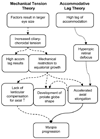Study of Theories about Myopia Progression (STAMP) design and baseline data
- PMID: 20935586
- PMCID: PMC3075061
- DOI: 10.1097/OPX.0b013e3181f6f776
Study of Theories about Myopia Progression (STAMP) design and baseline data
Abstract
Purpose: The Study of Theories about Myopia Progression (STAMP) is a 2-year, double-masked, randomized clinical trial of myopic children 6 to 11 years of age. STAMP will evaluate the 1-year effect of progressive addition lenses (PALs) compared with single vision lenses (SVLs) on central refraction, peripheral refraction in four quadrants, and accommodative response and convergence. STAMP will also evaluate any changes 1 year after discontinuing PALs. Baseline characteristics of enrolled children are reported.
Methods: Eligible children had a high accommodative lag and either low myopia (less myopic than -2.25 diopter (D) spherical equivalent) or high myopia (more myopic than -2.25 D spherical equivalent) and esophoria at near. Children were randomly assigned to wear either PALs or SVLs for 1 year to determine the difference in myopia progression in the PAL group relative to the SVL group. All children will then wear SVLs for the 2nd year to evaluate the permanence of any treatment effect. Complete ocular biometric data are collected at 6-month intervals.
Results: Over 17 months, 192 children were screened, and 85 (44%) were eligible and enrolled. Of these 85 children, 44 (52%) were girls, and 54 (64%) were esophoric at near. The mean age (± SD) was 9.8 ± 1.3 years. The right eye mean cycloplegic spherical equivalent refractive error was -1.95 ± 0.78 D. Horizontal relative peripheral hyperopia (30° nasal retina + 0.56 ± 0.59 D; 30° temporal retina + 0.61 ± 0.77 D) and vertical relative peripheral myopia (30° superior retina -0.36 ± 0.92 D; 20° inferior retina -0.48 ± 0.83 D) were found.
Conclusions: The baseline data for STAMP are reported. Asymmetry between vertical and horizontal meridian relative peripheral refraction was found. STAMP will use the ocular biometric changes associated with the PAL treatment effect to attempt to elucidate the mechanism responsible for the treatment effect.
Figures




References
-
- Vitale S, Sperduto RD, Ferris FL., 3rd Increased prevalence of myopia in the United States between 1971–1972 and 1999–2004. Arch Ophthalmol. 2009;127:1632–1639. - PubMed
-
- Charman WN. Near vision, lags of accommodation and myopia. Ophthalmic Physiol Opt. 1999;19:126–133. - PubMed
-
- Goss DA, Hampton MJ, Wickham MG. Selected review on genetic factors in myopia. J Am Optom Assoc. 1988;59:875–884. - PubMed
-
- Goss DA, Rainey BB. Relationship of accommodative response and nearpoint phoria in a sample of myopic children. Optom Vis Sci. 1999;76:292–294. - PubMed
Publication types
MeSH terms
Grants and funding
LinkOut - more resources
Full Text Sources

